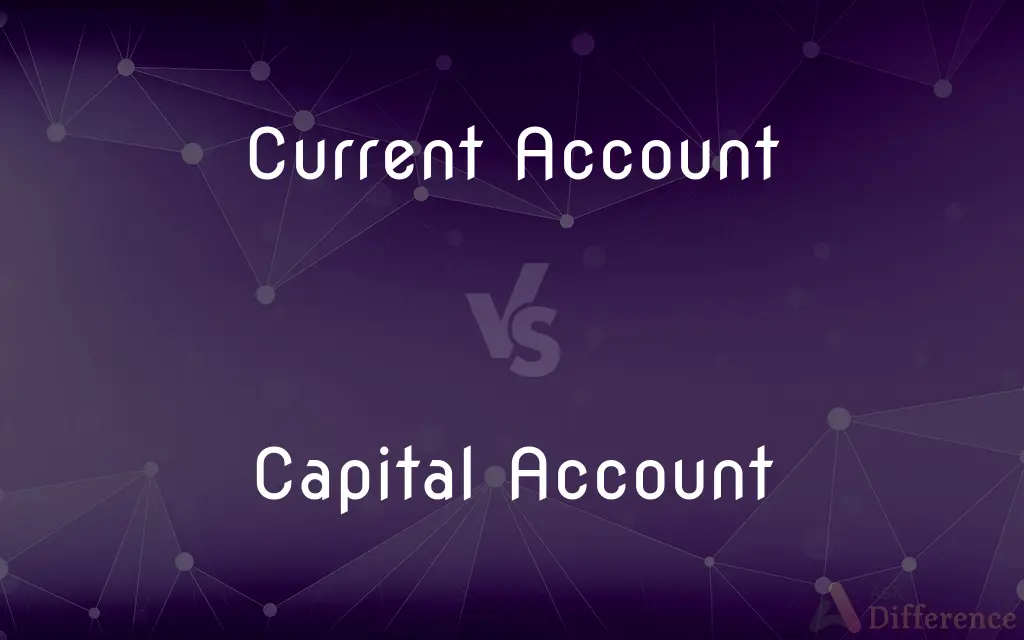Current Account vs. Capital Account — What's the Difference?
By Tayyaba Rehman — Published on October 14, 2023
The Current Account tracks trade in goods and services, while the Capital Account records capital transfers and purchase or sale of non-financial assets.

Difference Between Current Account and Capital Account
Table of Contents
ADVERTISEMENT
Key Differences
The Current Account deals with transactions of goods, services, income, and current transfers, acting as a reflection of a nation's net income. On the other hand, the Capital Account deals with the exchange of capital, including financial assets and liabilities, highlighting a nation's external assets and liabilities.
Transactions under the Current Account are short-term and recurrent, including items like exports and imports of goods, services, and unilateral transfers. In contrast, the Capital Account captures long-term transactions, encompassing foreign investments and loans.
The Current Account is crucial for evaluating a country's trade balance, indicating whether a country is a net lender or borrower. The Capital Account, however, offers insights into how the country finances its deficit or what it does with its surplus.
A deficit in the Current Account means a country is spending more on foreign trade than it is earning. In parallel, a deficit in the Capital Account indicates more capital is leaving the country than coming in.
Comparison Chart
Nature of Transactions
Deals with trade of goods and services
Handles capital transfers and non-financial assets
ADVERTISEMENT
Duration of Transactions
Short-term and recurrent
Long-term
Significance
Indicates trade balance and nation's net income
Shows nation's external assets and liabilities
Types of Transactions
Imports, exports, services, unilateral transfers
Foreign investments, loans, buying/selling of assets
Deficit Implication
Country spends more on foreign trade than earning
More capital leaving than entering
Compare with Definitions
Current Account
Reflects whether a country is a net lender or borrower.
Persistent deficits in the current account might raise concerns about economic sustainability.
Capital Account
Represents the purchase and sale of non-financial assets.
Acquiring land in another country would appear in the capital account.
Current Account
Measures the flow of goods, services, and unilateral transfers.
The current account tracks both merchandise trade and services rendered.
Capital Account
Captures financial transactions like foreign investments and loans.
When a country borrows from international lenders, it's noted in the capital account.
Current Account
Represents short-term, recurrent transactions.
Monthly import and export data are parts of the current account.
Capital Account
Chronicles the flow of capital transactions between countries.
Foreign direct investments are recorded in the capital account.
Current Account
A record of a country's trade in goods and services.
A deficit in the current account indicates more imports than exports.
Capital Account
Indicates how a nation finances its deficit or uses its surplus.
If a country has a current account deficit, the financing might be reflected in the capital account.
Current Account
Indicates a nation's net income from abroad.
A surplus in the current account shows the country has positive net earnings.
Capital Account
Gives insights into a nation's external assets and liabilities.
The capital account helps track a country's international financial position.
Common Curiosities
Can a country have a surplus in both accounts simultaneously?
Theoretically, yes, but typically if the Current Account has a surplus, the Capital Account will have a deficit, and vice versa.
What's a primary concern with consistent Current Account deficits?
Persistent Current Account deficits can raise questions about a country's economic sustainability.
How does the Capital Account differ from the Current Account?
The Capital Account deals with capital transfers and non-financial assets, whereas the Current Account handles trade transactions.
How does the Capital Account affect a nation's external financial position?
The Capital Account provides insights into a country's international assets and liabilities.
How are foreign direct investments documented in these accounts?
Foreign direct investments are recorded in the Capital Account.
How does a country finance its Current Account deficit?
Typically, a country finances its Current Account deficit through inflows captured in the Capital Account.
What does the Current Account primarily record?
The Current Account primarily records trade in goods and services.
What happens when there's a deficit in the Capital Account?
A Capital Account deficit indicates more capital is leaving the country than entering.
Does the Current Account include services rendered to other countries?
Yes, the Current Account includes the trade of both goods and services.
Is the Current Account concerned with long-term or short-term transactions?
The Current Account deals with short-term, recurrent transactions.
Share Your Discovery

Previous Comparison
General Reserve vs. Capital Reserve
Next Comparison
Polycrystalline vs. MonocrystallineAuthor Spotlight
Written by
Tayyaba RehmanTayyaba Rehman is a distinguished writer, currently serving as a primary contributor to askdifference.com. As a researcher in semantics and etymology, Tayyaba's passion for the complexity of languages and their distinctions has found a perfect home on the platform. Tayyaba delves into the intricacies of language, distinguishing between commonly confused words and phrases, thereby providing clarity for readers worldwide.













































